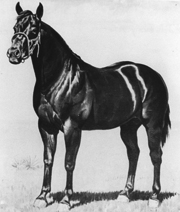As the geneticist and molecular biologist who developed a test to positively identify HERDA carriers, as well as a Quarter Horse owner, Nena Winand DVM, PhD finds herself wearing many hats these days.
“I got an e-mail from a man the other night and one third of his herd are carriers,” related Winand, an associate professor at Cornell University. “He wanted to know where he goes from here.
“There is a lot of breeder counseling involved because of the prevalence (of the disease),” she added. “A person needs to be conversant enough with the breed and with the performance of the sub-bloodlines to effectively deal with the situation.”
Winand’s immediate goal, however, is to let people know that the test is available and that it is one hundred percent accurate. “I just hope people will test their horses,” she said. “My only goal in this is to help breeders do what is right for the health and welfare of the horses. I live and breathe cutting horses.”
 Winand has traced the disease back to Poco Bueno (pictured), a foundation sire of Quarter Horse performers, who figures prominently in modern cutting horse pedigrees. “I paid for this work myself, with the help of some (Quarter Horse) breeders, because I wasn’t comfortable with some of the data I was seeing. I also own a Doc O’Lena granddaughter and I wasn’t going to sit on my rear and wait.”
Winand has traced the disease back to Poco Bueno (pictured), a foundation sire of Quarter Horse performers, who figures prominently in modern cutting horse pedigrees. “I paid for this work myself, with the help of some (Quarter Horse) breeders, because I wasn’t comfortable with some of the data I was seeing. I also own a Doc O’Lena granddaughter and I wasn’t going to sit on my rear and wait.”
HERDA manifests itself as a collagen defect in the skin, resulting in sores and lesions that heal poorly, if at all, and render horses unrideable. Afflicted horses are usually euthanized because of a poor prognosis.
A homozygous recessive gene causes HERDA and both parents must carry the gene for offspring to be afflicted. Since carriers are not afflicted with the disease, up until now, it has been difficult to positively identify them.
But laws of genetics dictate that there is a 25 percent chance that offspring of two carriers will develop the disease and that 50 percent will be carriers. When an afflicted horse is crossed with a carrier, the offspring will be either carriers of or afflicted with the disease; and when an afflicted horse is crossed with a normal horse, 100 percent of the offspring will be carriers.
“I think cases were occurring sporadically for a long time,” Winand said. “But I don’t know that people would have recognized anything about it. The human diseases that are sort of similar weren’t even understood until the late 1990s, in terms of genetics. Even in the past few years, people kept denying it was out there. There was a lot of resistance.
“It’s very different from even HYPP, which was prevalent, but a dominant trait, where you could, with few exceptions, see whether a horse was affected or not. If you look at the general (Quarter Horse) performance population, the HERDA carrier rate is 13 percent, which is quite high. You don’t see it at all in race horses, but when you get into hardcore cutting horses, it’s 25 to 30 percent.”
Winand sees the HERDA test as an important step forward in managing the trait.
“I’d love to just tell people that they can’t breed horses with genetic defects, but that’s not practical. I think if we just manage it from the standpoint of trying to avoid carrier-to-carrier matings, it is probably the most productive route to take at this time. It won’t eliminate the trait from the gene pool. You can’t do that unless you cull out all of the carriers.”
According to Winand, advances in reproductive technology, together with line-breeding and inbreeding practices, helped fuel the fire for HERDA. She notes that one stallion, who is still standing, has 56,000 registered descendants. “My resistance to cloning is because of that,” she admitted. “How much influence of one individual is acceptable or good? Those questions are always fun to debate and hard to really answer.
“My gut feeling is that when you start to see the emergence of recessive traits, health issues and financial loss as a consequence, that’s when you need to start to back off the inbreeding. That’s typically the index that we use as geneticists and veterinarians.”
Winand’s research has not ended with the development of the test to identify HERDA carriers. “There are also soundness issues in these bloodlines. It may be related to HERDA carriers or it may not. Those are polygenic traits and we want to understand them. That is where we are going with this now. We want to build a better cutting horse.”
For information on HERDA testing: Nena Winand, DVM, PhD, Department of Molecular Medicine, College of Veterinary Medicine, Cornell University, Ithaca, NY, 607-253-3608, njw2@cornell.edu.
